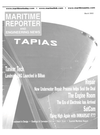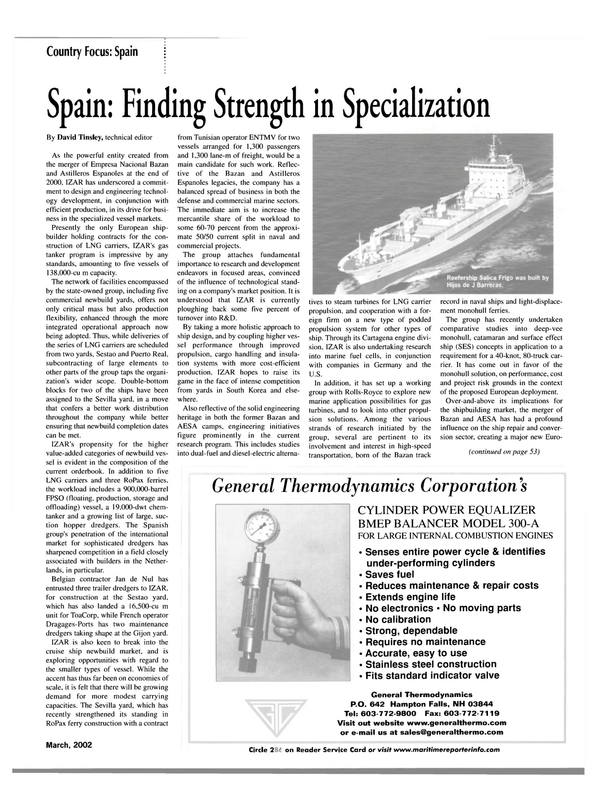
Spain: Finding Strength in Specialization
As the powerful entity created from the merger of Empresa Nacional Bazan and Astilleros Espanoles at the end of 2000, IZAR has underscored a commitment to design and engineering technology development, in conjunction with efficient production, in its drive for business in the specialized vessel markets.
Presently the only European shipbuilder holding contracts for the construction of LNG carriers, IZAR's gas tanker program is impressive by any standards, amounting to five vessels of 138,000-cu m capacity.
The network of facilities encompassed by the state-owned group, including five commercial newbuild yards, offers not only critical mass but also production flexibility, enhanced through the more integrated operational approach now being adopted. Thus, while deliveries of the series of LNG carriers are scheduled from two yards, Sestao and Puerto Real, subcontracting of large elements to other parts of the group taps the organization's wider scope. Double-bottom blocks for two of the ships have been assigned to the Sevilla yard, in a move that confers a better work distribution throughout the company while better ensuring that newbuild completion dates can be met.
IZAR's propensity for the higher value-added categories of newbuild vessel is evident in the composition of the current orderbook. In addition to five LNG carriers and three RoPax ferries, the workload includes a 900,000-barrel FPSO (floating, production, storage and offloading) vessel, a 19,000-dwt chemtanker and a growing list of large, suction hopper dredgers. The Spanish group's penetration of the international market for sophisticated dredgers has sharpened competition in a field closely associated with builders in the Netherlands, in particular.
Belgian contractor Jan de Nul has entrusted three trailer dredgers to IZAR.
for construction at the Sestao yard, which has also landed a 16,500-cu m unit for ToaCorp, while French operator Dragages-Ports has two maintenance dredgers taking shape at the Gijon yard.
IZAR is also keen to break into the cruise ship newbuild market, and is exploring opportunities with regard to the smaller types of vessel. While the accent has thus far been on economies of scale, it is felt that there will be growing demand for more modest carrying capacities. The Sevilla yard, which has recently strengthened its standing in RoPax ferry construction with a contract from Tunisian operator ENTMV for two vessels arranged for 1,300 passengers and 1,300 lane-m of freight, would be a main candidate for such work. Reflective of the Bazan and Astilleros Espanoles legacies, the company has a balanced spread of business in both the defense and commercial marine sectors.
The immediate aim is to increase the mercantile share of the workload to some 60-70 percent from the approximate 50/50 current split in naval and commercial projects.
The group attaches fundamental importance to research and development endeavors in focused areas, convinced of the influence of technological standing on a company's market position. It is understood that IZAR is currently ploughing back some five percent of turnover into R&D.
By taking a more holistic approach to ship design, and by coupling higher vessel performance through improved propulsion, cargo handling and insulation systems with more cost-efficient production. IZAR hopes to raise its game in the face of intense competition from yards in South Korea and elsewhere.
Also reflective of the solid engineering heritage in both the former Bazan and AESA camps, engineering initiatives figure prominently in the current research program. This includes studies into dual-fuel and diesel-electric alternatives to steam turbines for LNG carrier propulsion, and cooperation with a foreign firm on a new type of podded propulsion system for other types of ship. Through its Cartagena engine division, IZAR is also undertaking research into marine fuel cells, in conjunction with companies in Germany and the U.S.
In addition, it has set up a working group with Rolls-Royce to explore new marine application possibilities for gas turbines, and to look into other propulsion solutions. Among the various strands of research initiated by the group, several are pertinent to its involvement and interest in high-speed transportation, born of the Bazan track record in naval ships and light-displacement monohull ferries.
The group has recently undertaken comparative studies into deep-vee monohull, catamaran and surface effect ship (SES) concepts in application to a requirement for a 40-knot, 80-truck carrier.
It has come out in favor of the monohull solution, on performance, cost and project risk grounds in the context of the proposed European deployment.
Over-and-above its implications for the shipbuilding market, the merger of Bazan and AESA has had a profound influence on the ship repair and conversion sector, creating a major new Euro- pean force while reshaping the industry in Spain. It has given a finer edge to competition in one of the world's most intensely contested areas of marine business.
Under the banner of IZAR Carenas, five repair yards encompassing 11 drydocks, one floating dock and a syncrolift- type system have been brought into a common ownership, catering to the needs of vessels up to 400,000-dwt.
The network comprises the former Bazan repair facilities at Ferrol, Cartagena and San Fernando, and the previously AESA-controlled Astano and Astilleros de Cadiz, all of which have now adopted an IZAR Carenas prefix.
Besides the scheduled drydockings and general repair work that provides the baseload business for the industry, each of the group's repair yards has a track record in distinct, specialist markets, and its own client contacts in the shipowning and shipmanagement communities worldwide. For this reason, IZAR Carenas decided that the yards be operated autonomously, albeit with a common management for the Ferrol and Fene facilities.
The early part of 2002 has witnessed a healthy level of incoming work, including conventional tanker-to-shuttle tanker conversions, and repair projects involving cruise ship and cablelayer tonnage.
The new business has followed what was regarded as a good year for the group. Over 400 vessels were received during 2001, and the division's estimated turnover was around $183.9 million, yielding a modest profit of $876,000.
IZAR Carenas Cadiz gave fresh expression to its longstanding position in the conversion and rebuild sector with the completion at the end of January 2002 of a major stability modification to the 12,684-gt French passenger-car ferry Corse. The vessel had arrived at the Cadiz yard in early November for a program of work which included dismantling the buoyancy tanks on the garage decks, removal of fittings and equipment for relocation on a modified hull, installation of new sponsons of total weight of approximately 300-tons, and painting and surface treatment. The yard also prepared the detailed engineering plans.
A subsequent project currently in hand entails the adaptation and completion of a hull, purchased from the Kherson Shipyard in the Ukraine, as a chemical tanker. The Cadiz shipyard was assigned basic and detailed engineering and comprehensive equipment and system supply and installation, bar the already insitu main engine, fitting of shaftline, propeller, rudder and steering gear, all accommodation work and painting throughout the ship. She is due to be delivered to Spanish operator in April this year.
In looking to widen its ambit still further, IZAR Carenas Cadiz hopes to enter the cruise ship repair market by October 2002. A dedicated team is to be created to handle such contracts, for which special provisions would be made as regards electrical supply to vessels while drydocked, along with garbage removal and other facilities on behalf of owners.
The integration of the Bazan and AESA interests has also created a new force in engine production. One of the jewels in the crown of Europe's twostroke diesel engine manufacturing sector, the Manises plant near Valencia gives particular weight to IZAR's activities in delivering large prime movers into the commercial marine market.
Although MAN B&W relinquished its 20 percent stake in the former Manises Diesel Engine Company to the then majority holder AESA in mid 2000, it entered into a wider, long-term licensing agreement with the company. The 10- year deal extended Manises' licensed area to the whole of the EU and Norwegian market, from its previous orientation to Spanish mainland and island territory.
A major deal for eight export engines struck with the factory in its pre- IZAR guise is now coming to fruition, putting Spanish-built two-strokes into the MAN B&W homeland. The program involved eight low-speed diesels totaling 192,250-bhp for delivery to eight containership newbuildings in Germany.
Read Spain: Finding Strength in Specialization in Pdf, Flash or Html5 edition of March 2002 Maritime Reporter
Other stories from March 2002 issue
Content
- Smit Develops High-Powered Wreck Removal Cutting System page: 4
- KMY To Consult on Icebreaker page: 8
- Bollinger To Build Three Boats for Chouest page: 9
- IFS And DNV Join Forces On IT Project page: 12
- Volvo Penta Signs $ 2 . 8M Tug Engine Contract page: 14
- Underwater Bonding Seals the Deal page: 17
- Grand Bahama Shipyard's Drydock Arrives page: 19
- One Cool Customer page: 21
- ReeferShip Ltd. Formed page: 23
- A.R. Larsen To Offer Turnkey Interior Services page: 23
- The Era of The Electronic Engine Is Here page: 24
- Rolls-Royce Package Approach Wins Order page: 25
- Innovation in the Engine Space page: 27
- Landmark LNG Carrier Launched by IZAR page: 28
- BY backs S&T Ecomax Tanker Design page: 31
- Maritrans Continues Double Hull Program page: 32
- French Snag LNG Order page: 32
- LR: Hearing is Believing page: 32
- Antifouling Paint Helps USCG Sink Maintenance Costs page: 36
- NSRP Projects Show Impressive Results page: 38
- Derecktor Wins AMHS Fast Ferry Deal page: 41
- Gas Turbines Continue Making Commercial Inroads page: 44
- Fleet F77 Extends Inmarsat's Offering s page: 46
- Spain: Finding Strength in Specialization page: 51


